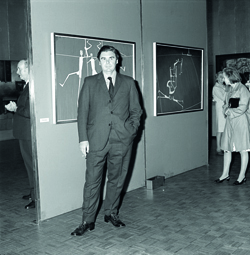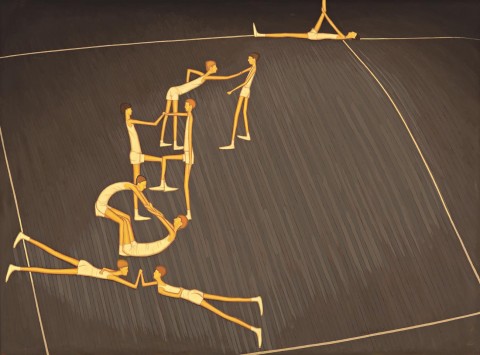FOUR PAIRS AND A SINGLE, 1971
JOHN BRACK
oil on canvas
96.5 x 130.5 cm
signed and dated lower right: John Brack 71
signed and inscribed with title on stretcher bar verso: “FOUR PAIRS AND A SINGLE” / JOHN BRACK
Joseph Brown Gallery, Melbourne, 1971
Private collection, Melbourne
Travelodge Art Prize, Travelodge, Melbourne, 29 October 1971
Travelodge Painting Prize: Travelodge Art Collection, National Gallery of Victoria, Melbourne, 4 – 28 November 1971 (partial label attached verso)
Grishin, S., The Art of John Brack, Oxford University Press, Melbourne, 1990, vol. II, cat. o196, pp. 26, 146 (illus.)
At the end of 1968 John Brack resigned from his position as head of the Melbourne National Gallery School where, for six years, he had maintained a painting studio behind his office. While he undertook a handful of commissions during these years and was represented in exhibitions including Australian Painting at London’s Tate Gallery (1963) and Australian Painters 1964-66: The Harold Mertz Collection at the Corcoran Gallery of Art, Washington DC (1967), the responsibilities of his role prevented Brack from producing any major new series. The impetus to leave his job was a deal struck with Rudy Komon, the bon vivant of Sydney art dealers, which saw him receive a monthly stipend offset against annual sales. For the first time in his life Brack was free to paint full-time and after constructing a purpose-built studio at home, he embarked on his most ambitious series to date on the theme of ballroom dancing – all gloss and artifice in vivid pinks and red.
While the colour, movement and fantasy of competitive ballroom dancing offered rich visual inspiration for Brack’s picture-making, it was the way in which this activity reflected aspects of human behaviour and relationships that he found especially compelling. As an artist who was primarily interested in understanding and illuminating the human condition1, Brack found his subject matter in the people and places around him, depicting what he saw in a way that communicated both the physical reality as well as the underlying psychological motivations. While the Gymnast series of 1971 – 72 that followed was partly based on observations of his own children, it continued the themes of performance and partnership that he had explored in the ballroom dancing pictures, as well as notions of vulnerability and precariousness. As Brack said, in these paintings ‘the idea … is related to balancing and falling, but not absolutely collapsing … it is stumbling, but not the abyss’.2
JOHN BRACK_Travelodge Painting Prize, Nov.jpg

The composition of paintings in the series varies in complexity, from the single pairs in Two Figures, The Low Bench and Back to Back (all private collections), to Three pairs, 1971 (Benalla Art Gallery), which depicts six young boys dressed in the exercise garb of the day, each working with a partner to stretch and limber up. One of the liveliest compositions within the series, Four Pairs and a Single, 1971 was entered with Three Pairs into the Travelodge Art Prize that year at the National Gallery of Victoria, the latter being awarded the $7,500 acquisitive prize. Writing in the Age, art critic Patrick McCaughey noted that ‘[Brack] transfixes his youthful gymnasts to the picture plane so that they neither float nor wilt but remain scrawnily human and gawkily agile’.3 The figures in Four Pairs and a Single read like angular calligraphic forms, the pale cream of their clothes and golden glow of their limbs set in contrast to the vast field of dark floorboards. While their lithe physicality is prominent, the prevailing element is the connection between the ‘four pairs’ of exercising youths and the almost overwhelming sense that, should their trusting collaboration falter, they will all fall down. This portentous tone is emphasised by the vertiginous tilt of the floorboards which threatens to tip the gymnasts off at any moment, as well as creating a decidedly ambiguous pictorial space. This perspectival distortion became a characteristic feature of Brack’s later work and, as he explained, was ‘part of the metaphorical system … [where] things are intended to operate on numerous levels of meaning … both balanced and unbalanced … moving and … still … In other words, these are premeditated ambiguities which are, as it were, the visual metaphor’.4 Within the visual metaphor of this picture it is ironic but surely symbolic that the ‘single’ figure working alone in the background is the one who appears most balanced and stable.
1. See Grant, K., ‘Human Nature: The Art of John Brack’ in Grant, K., et. al., John Brack, exhibition catalogue, National Gallery of Victoria, Melbourne, 2009, p. 87
2. Brack, J., quoted in ‘John Brack on John Brack’, Fine Art Programme (lecture), Australian National University, Canberra, 19 September 1977, transcript, p. 7
3. McCaughey, P., ‘Richest award to John Brack’, The Age, Melbourne, 30 October 1971, p. 2
4. Brack, J. interviewed in Australian Contemporary Art Archive, no. 1, Deakin University Media Production, 1980, transcript, p. 5
KIRSTY GRANT
